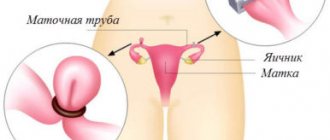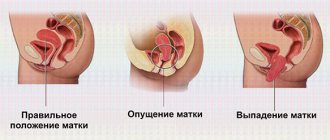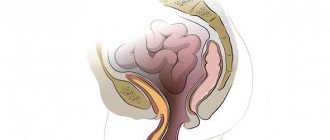Many women, with age or after illnesses, face the problem of prolapse or prolapse of the uterus - prolapse. This phenomenon not only causes physical and psychological discomfort, but is also fraught with the occurrence of various diseases. When surgical intervention is impossible, a special device is called upon to solve the problem - a gynecological ring (pessary). The article describes the indications, effect, advantages and disadvantages of this method of treating prolapse.
What gynecological rings are used for uterine prolapse?
In gynecological practice, vaginal pessaries are used to eliminate problems caused by incompetence of the pelvic muscles in women. Silicone vaginal rings help with the initial stages of genital prolapse and urinary incontinence syndrome. According to the instructions, after insertion into the vaginal canal, the gynecological pessary takes the desired shape, helps maintain the pelvic organs in the anatomically correct position and prevents their loss.
By design, vaginal pessaries are:
- urethral - have a ring shape, help with problems with urinary incontinence in women;
- mushroom-shaped - made in the shape of a ring on a stem, according to the instructions they are used to support the pelvic organs in the desired position in case of severe development of the disease;
- cup - vaginal devices of this shape help with the initial stages of prolapse;
- urethral-cup - combined type products help women with prolapse of the genital organs, accompanied by urinary incontinence syndrome;
- cubic – filling vaginal pessaries according to the instructions help in difficult cases of uterine prolapse;
- Hodge ring - suitable for women with anatomical features of the structure of the genitals; increased elasticity helps the gynecological silicone ring take the desired shape after installation.
Which vaginal ring for uterine prolapse helps in a particular situation is determined by the doctor, taking into account the complexity of each specific case.
(see video after article)
Reviews
Women have positive opinions about the gynecological ring. Most patients are satisfied with the results of use. After installing the system, they experience the following symptoms:
- pain in the perineum;
- urinary and fecal incontinence;
- recurring inflammation of the cervix;
- bleeding from the genital tract.
You can also hear that the ring, when lowered, leads to frequent infection of the vagina. This is accompanied by itching, burning, and copious discharge. Indeed, if used incorrectly and without periodic sanitation of the genital organs, the systems create favorable conditions for the development of pathogenic microorganisms. Therefore, doctors strongly recommend wearing the pessary no longer than the prescribed period and cleaning it regularly.
Using a pessary makes it possible to temporarily postpone surgery for uterine prolapse. This is especially necessary for women with stages 3 and 4 of the pathological process.
Patients also report that they continue to wear the system after surgical treatment. The ring relieves the pelvic floor muscles and prevents relapse of prolapse. However, in this case, it is necessary to choose a different ring, since for each stage of displacement of the pelvic organs the shape and size are selected individually.
Why use a vaginal pessary for uterine prolapse?
Partial and complete uterine prolapse is subject to mandatory correction for the following reasons:
- The low position of the cervix and the gaping of the genital slit help the infection to penetrate the vaginal canal, causing the development of colpitis and cervicitis.
- Prolapse of the vaginal walls and the anterior wall of the bladder changes the anatomical position of the urethra, which leads to the development of stress urinary incontinence. The appearance of a persistent odor of urine sharply reduces the quality of life and limits a woman’s communication.
- Problems with urination in women lead to the development of cystitis and pyelonephritis.
- Irritation by urine of the skin and mucous membranes of the genital organs leads to their inflammation, including pyoderma and eczema.
- The uterus and vaginal walls swell during prolapse and can become pinched in the genital slit. Impaired blood circulation in organs leads to their necrosis, which causes serious gynecological consequences.
- Complete inversion of the uterus during prolapse is possible.
A gynecological uterine ring in case of uterine prolapse helps prevent the development of complications of genital prolapse.
The best gynecological pessaries. Features and prices
Under the trademarks Juno, Dr. Arabin, as well as Simurgh, produce high-quality pessaries of all types for daily use.
Juno
The table below shows the average prices for Juno gynecological pessaries.
| Name of medical device | Price |
| Mushroom | 3900 rub. |
| Calyceal-urethral | 3900 rub. |
| Khoja | 3900 rub. |
| Obstetric (unloading) | 975 rub. |
Gynecological pessaries "Juno" are made from medical silicone, which does not contain harmful impurities.
Dr. Arabin
The table below shows the average cost of support pessaries of the Dr. brand. Arabin."
| Name of medical device | Price |
| Cubic | 5090 rub. |
| Thin uterine ring | 5090 rub. |
| Cup | 5090 rub. |
| Urethral | 5090 rub. |
Gynecological pessaries “Dr. Arabin" can be used for the treatment and prevention of diseases of the female reproductive system.
Simurgh
The table below lists the types of gynecological pessaries “Simurg”, as well as their average prices.
| Name of medical device | Price |
| Obstetric (unloading) | 1700 rub. |
| Cubic | 3590 rub. |
| Cervical (perforated) | 3100 rub. |
| thick ring | 3100 rub. |
The best and best-holding gynecological pessaries are medical products that are designed to eliminate prolapse of internal organs and muscle tissue located in the pelvic area. Devices of this type are inserted into the upper part of the vaginal vault with their secure fixation in the cavity of the birth canal.
The use of pessaries helps prevent prolapse and prolapse of the uterus, displacement of the bladder, and maintains the anatomically correct position of the internal organs. The selection of medical products in this category is the task of a gynecologist who installs a gynecological device of the type that is necessary for a patient with a specific genitourinary disease.
Classification of vaginal pessaries for uterine prolapse
In women, genital prolapse is classified depending on the degree of organ prolapse in relation to the planes of the pelvis and genital fissure.
I degree of genital prolapse is characterized by some prolapse of the uterus. In this case, its neck is located below the plane of the narrow part of the pelvis and, even with straining, does not appear from the genital slit; at the same time, prolapse of the anterior or posterior vaginal walls may be observed.
Gynecological silicone pessaries for first degree prolapse help women maintain organs in the desired position. According to the instructions, a silicone uterine ring for first degree prolapse helps eliminate the gynecological problem. In addition, vaginal cup pessaries can be used.
The second degree of genital prolapse in women is an incomplete prolapse of the uterus, a condition in which the cervix, when straining, extends beyond the genital slit, but when lying down and performing Kegel exercises, it returns to the vaginal canal.
With the second degree of genital prolapse in women, as with the first, a vaginal ring pessary or a silicone gynecological “cup” helps. According to the instructions, they provide reliable support for the pelvic organs, help fix the uterus in the anatomically correct position and do not allow the vaginal walls to sag.
III degree of genital prolapse in women is a state of complete prolapse of the uterus, when it appears entirely outside the genital slit at the slightest physical strain, coughing, sneezing, laughing, and even simply when moving from a horizontal to a vertical position. The organ cannot be adjusted on its own. Objectively: a pineal formation protrudes from the genital fissure - a swollen, cyanotic neck, often covered with decubital ulcers. This is followed by a hernial sac formed by the vaginal walls, inside which is the body of the uterus. The mucous membrane of the vaginal walls and cervix looks smooth, dry, thinned, like skin. Uterine prolapse causes displacement of the posterior wall of the bladder (vesicocele) and the anterior wall of the rectum (rectocele).
Treating uterine prolapse in women is not an easy task. If surgery is not possible, gynecological vaginal pessaries help, but difficulties arise here too. According to the instructions, before installing a vaginal silicone ring for women with uterine prolapse, gynecological anti-inflammatory treatment is carried out. To install a silicone vaginal pessary, it is necessary to restore the vaginal and cervical mucosa and heal decubital ulcers.
Which vaginal pessary helps with stage III uterine prolapse? According to the instructions, a gynecological pessary should have a filling effect, that is, it should completely occupy the entire volume of the vagina, preventing the uterus and vaginal walls from descending.
A conventional silicone gynecological ring for stage III uterine prolapse does not help a woman cope with these functions. The force of pressure of the internal genital organs on the silicone vaginal pessary is such that when the uterus prolapses, it is easily pressed through the large internal opening of the silicone device and is pinched in it, which is fraught with necrosis of the organ and the development of severe complications.
According to the instructions, with complete prolapse of the uterus, a thick vaginal ring of the “doughnut” type, a mushroom-shaped or cubic pessary helps.
What is a pessary
A pessary is a device made of hypoallergenic silicone, which is actively used in gynecological practice. This system allows you to prevent and also stop the development of certain diseases of the intimate sphere, including during pregnancy.
Manufacturers of uterine rings use environmentally friendly materials that do not harm the female body. The elasticity of the device allows it to be used at different stages of prolapse. After insertion, the ring easily adapts to the shape of the patient’s genital organs and does not cause discomfort. Like any method of treating uterine prolapse, a pessary has its own advantages and disadvantages.
Advantages of a gynecological ring for prolapse of the uterus:
- returns the uterus to its normal anatomical location,
- allows you to do without surgery,
- effective for all forms and stages of prolapse,
- does not injure the mucous membrane of the genital organs,
- does not cause discomfort,
- can be used for a long time,
- has different prices, suitable for any budget,
- suitable for multiple administrations,
- allowed for independent use.
Disadvantages of the ring in the treatment of uterine prolapse:
- increases the risk of inflammatory processes,
- does not solve the problem completely, since after removal the organs are lowered to their original position,
- excludes the possibility of intimacy,
- provokes an increase in the volume of vaginal discharge,
- creates psychological discomfort for a woman,
- requires constant care and treatment with antiseptics,
- forces the patient to regularly sanitize the vagina,
- During the first months of wearing, the patient is required to be examined by a gynecologist every 2 weeks.
Indications for placement of a vaginal ring in case of uterine prolapse
According to the instructions, treatment of prolapse by installing a silicone vaginal ring is not able to permanently return the pelvic organs to their normal anatomical position, but it helps the woman lead a normal lifestyle, work and communicate with other people.
Non-surgical therapy helps if, for some reason, surgery cannot be performed. Only a surgeon’s scalpel can help get rid of a gynecological problem forever. This must be taken into account before installing a vaginal pessary.
According to the instructions, the silicone vaginal ring helps women with the following indications:
- stress-type urinary incontinence syndrome;
- rectocele II-IV degree;
- cystocele II-IV degree;
- uterine prolapse of I-III degree;
- woman's refusal to undergo surgery.
The vaginal gynecological system is also prescribed to women in the postoperative period. According to the instructions, it helps reduce the load on the pelvic muscles for rapid tissue restoration.
Advantages and disadvantages of using uterine rings
The advantages of using a pessary include:
- The ability to get rid of prolapse without surgery.
- Correction of the position of the uterus at various stages.
- Preventing the risk of organ injury.
- Ease of treatment with the right choice of device type.
Despite the significant list of positive aspects, there are also disadvantages in the use of gynecological rings that force patients to abandon this method of treatment. Among them the following are noted:
- Risk of inflammation of the urethra and vaginal walls at the site of contact with the pessary. In elderly patients, the mucous membrane is more susceptible to infections.
- The need to try several different types of pessaries to determine the most suitable one, which is quite expensive and inconvenient.
- Discomfort when wearing due to incorrectly selected size or increased amount of discharge.
Instructions for installing a vaginal ring
According to the instructions, a doctor installs a uterine ring in case of uterine prolapse on an outpatient basis. Before the procedure, the woman undergoes a gynecological examination, which helps to exclude contraindications to the placement of a silicone vaginal pessary.
The size of the silicone vaginal device is determined by the gynecologist according to the instructions. A special set of adaptation vaginal rings helps him with this. If the diameter of the silicone gynecological system is chosen correctly according to the instructions, the woman will not experience discomfort after installation.
According to the instructions, before installing a silicone vaginal pessary, it must be sterilized. More often, the gynecological system is treated with hydrogen peroxide. The doctor then lubricates the silicone vaginal ring with Vaseline, which helps to quickly install the device, and inserts it into the woman’s vaginal canal. A vaginal pessary is fixed on the cervix, lifts the uterus and helps maintain it in its natural position. In the future, a woman needs to learn how to install a silicone gynecological system herself, using the instructions.
How to use a gynecological ring: instructions and recommendations
Cubic, like mushroom-shaped vaginal pessaries, according to the instructions, can be used for no more than a day, so they need to be removed daily in the evening before bed. According to the instructions, silicone vaginal rings can be worn for up to 5 days. If a woman does not need a vaginal pessary at night, it is also removed before bed. After removal, the silicone device is washed with soap and water, dried and placed in a bag or container.
Rules for using a silicone vaginal pessary are specified in the instructions for use. Each manufacturer's instructions give women their own recommendations for sterilization and storage, which help extend the service life of the gynecological vaginal device.
General rules for using a silicone gynecological ring for uterine prolapse:
- do not exceed the period of wearing the silicone product prescribed by the doctor;
- remove the vaginal device for antiseptic treatment;
- sterilize the gynecological pessary in a 3% peroxide solution;
- maintain the processing time specified in the instructions.
At the appointment, the doctor also gives the woman detailed instructions on how to remove/insert the vaginal pessary. It is recommended to remove the gynecological silicone ring while standing, raising one leg, or squatting. In the same way, using the instructions, the vaginal device is installed. To prevent injury to the mucous membrane and to quickly insert the silicone product, lubricate it with Vaseline or other lubricant (see instructions).
Contraindications to the use of silicone vaginal rings
According to the instructions, the ring should not be installed in case of uterine prolapse in the following cases:
- oncology of the pelvic organs;
- allergy to the material from which the gynecological pessary is made;
- infectious and inflammatory diseases of the genital organs;
- the presence of tumors in the uterine or abdominal cavity, vaginal canal;
- erosion of the cervix and vaginal canal;
- bloody discharge of unknown etiology;
- pathologies of development of the appendages/uterus;
- history of complications after insertion of a vaginal ring.
If, during a gynecological examination, a woman is diagnosed with infections or inflammatory processes in the pelvic organs, then according to the instructions, a silicone vaginal ring can be placed in case of uterine prolapse only after a course of treatment.
How much do gynecological rings cost?
The price of a vaginal pessary starts from 250 rubles and can reach several thousand. The cost depends on the manufacturer, design and material from which the vaginal product is made. The brands “Juno” and Dr. are in greatest demand among women. Arabin.
The specialist selects the required gynecological system after a thorough examination, taking into account the woman’s age, the stage of genital prolapse, and associated complications. According to the instructions, if genital prolapse in a patient is accompanied by urinary incontinence and bladder prolapse, urethral or vaginal filling pessaries help. Such gynecological vaginal systems will cost women more than simple silicone devices.
The most reliable retention pessaries in gynecology
Each type of gynecological pessaries is indicated for use in a specific clinical case of a painful condition of the organs of the female reproductive system.
Before using a certain type of medical device in this category, the current symptoms of the disease, the individual characteristics of the anatomical structure of the patient’s body, as well as the degree of weakening of the functional activity of the pelvic floor muscles are taken into account.
Urethral
The best and best-holding gynecological pessary is the urethral type of fixation device. The medical product is made from high-quality medical silicone. Externally, the urethral pessary resembles a ring, which is decorated with an additional element that acts as a seal.
The device is indicated for use by women who suffer from urinary incontinence that occurs when performing the following actions:
- sneezing;
- cough;
- laughter;
- performing bends;
- lifting objects weighing more than 3 kg;
- playing sports;
- performing heavy physical labor.
The principle of operation of a urethral pessary is that its sealing part exerts compression on the walls of the urethra, preventing spontaneous leakage of urine.
In fact, this product performs the function of the pelvic floor muscles, which are inactive due to weakness, inflammation or the presence of a concomitant disease. The urethral pessary can remain in the vaginal cavity for 3 to 20 days.
The urethral pessary contains a metal spring inside, which provides the medical product with sufficient elasticity and also performs the function of squeezing the upper part of the urethral canal. The minimum diameter of this type of gynecological device is 45 mm. The largest urogenital pessary is within 100 mm.
During installation of this gynecological device, the vaginal ring is pushed upward through the vaginal vault, and the sealing element is located below, exerting pressure on the walls of the urethra. The only drawback of the urogenital pessary is that while wearing it, the elasticity of the vaginal walls weakens.
Over time, the question of using a medical device of an increasingly larger size arises. The average cost of urogenital pessaries is 5090 rubles. for 1 piece
Thin uterine ring
Gynecological pessaries (the best, well-retaining products of this type can be purchased at a pharmacy) are produced in the form of a thin uterine ring. This device is made of a metal spring, which is coated with a dense layer of medical silicone.
A pessary in the form of a thin uterine ring is used to hold the patient's bladder in an anatomically correct position. Due to this, it is possible to achieve the effect of preventing urinary incontinence, as well as its involuntary leakage at the moment of creating a load on the muscles of the lower abdomen and pelvic floor.
The minimum size of a pessary in the form of a thin uterine ring is 50 mm. The largest device of this type has a diameter of 100 mm. The first installation of a pessary of this type is performed directly by the gynecologist himself.
After this, the doctor tells the patient how to properly use this product, as well as independently fix it in the organs of the reproductive system. The installation of a thin uterine ring is performed inside the upper vaginal vault. At the time of insertion of the gynecological device, the woman should be in a lying position.
In order to avoid the negative consequences and complications associated with constantly wearing a thin uterine ring, it is recommended to remove it daily with further hygiene procedures. The medical device itself must be washed with warm water without using special disinfectants.
After this, the thin uterine ring can be returned to the upper vaginal vault. Patients whose genitourinary system is postmenopausal are allowed to use this pessary with intravaginal administration of estrogen-based drugs. The average cost of a thin uterine ring is around 3,690 rubles. for 1 piece
Thick uterine ring
Gynecological pessaries (the best, well-retaining devices of this type should be prescribed by the attending physician) are used on an ongoing basis until the pelvic floor muscles are completely restored.
The thick uterine ring is designed in such a way that its structural core is a metal spring. The function of holding the bladder in an anatomically correct position is achieved through a wider base of the medical product, which is made using high-quality silicone.
A thick uterine ring is indicated for use to achieve the following therapeutic and preventive effect:
- prevention of bladder displacement;
- suppression of involuntary urine leakage;
- preventing the development of systematic urinary incontinence under the influence of physical activity on the lower abdomen (bending over, heavy work, sneezing).
Installation of a thick uterine ring is performed according to a similar principle as in the case of fixing this product with a thinner layer of medical silicone. This type of gynecological device should be located in the upper vaginal vault.
A pessary in the form of a thick uterine ring is recommended for use by elderly patients, since wearing this medical product minimizes the risk of developing necrosis of the vaginal walls. This gynecological device is replaced at least once a week. The average cost of a thick uterine ring is 3,790 rubles. for 1 piece
Cup
Gynecological pessaries (the best, well-holding medical products in this category are made of hypoallergenic materials) can be used as an alternative to surgical operations.
Cup-type fixing devices are used for the treatment and prevention of the following pathologies of the female reproductive system:
- prolapse of the reproductive organs;
- uterine prolapse;
- displacement of organs located in the pelvic area.
Cup pessaries belong to the category of special medical products that allow you to achieve an excellent therapeutic effect and also avoid surgical intervention.
The minimum size of this gynecological device is 55 mm, and the maximum is 95 mm. Cup pessaries are made of high quality silicone. This product is inserted into the vaginal cavity in a compressed form by squeezing it with your fingers. The process of installing a cup pessary is painless due to the good elasticity of the material.
The cup pessary acquires its rounded shape directly inside the vagina after its installation is completed in the upper part of the vault of the birth canal. This medical device is equipped with holes that are designed for the outflow of secretion products.
In this case, the effect of preventing inflammatory diseases and other complications associated with the presence of a foreign body inside the reproductive organ is ensured.
When using a cup pessary, it is recommended to use an estriol-based cream, which facilitates the fixation of the gynecological product and also protects the woman’s genitourinary system from the development of infectious microorganisms.
Cup pessaries have the following contraindications for their use:
- inflammatory processes in the organs of the reproductive system;
- concomitant diseases of the genitourinary system, which can lead to the occurrence of malignant neoplasms in the tissues of the cervix;
- other pathologies of the uterus and vagina that exclude the installation of this device.
Cup pessaries are recommended to be worn only during the daytime, removing them from the vaginal cavity before going to bed. Re-installation of the gynecological product is carried out in the morning. This type of medical device is maintained by rinsing it under warm water. The use of aldehyde-based solutions is allowed as antiseptics.
The cup pessary is stored at room temperature, and this product is sterilized only with water steam. The average cost of gynecological devices of this type is within 5,400 rubles. for 1 piece
Mushroom
Gynecological pessaries (the best, well-retaining products in this category allow you to avoid complications associated with prolapse of the pelvic floor muscles) are prescribed for installation only after a thorough examination of the organs of the reproductive system. Particular attention is paid to the anatomical location of the uterus, and the risks of its prolapse or prolapse are assessed.
The use of a mushroom-shaped pessary is indicated in cases where the use of other types of gynecological devices does not allow for high-quality support of the bladder, vagina and uterus. This medical device is used for patients who, based on the results of a diagnostic examination, have been diagnosed with grade 3 or 4 pelvic organ prolapse.
Wearing a mushroom pessary allows you to achieve the following therapeutic effect:
- creates reliable support for the tissues of the internal organs, which are located in the pelvic area (the implementation of these properties of the gynecological device is ensured by the presence of a wide cap of the device, reminiscent of a small mushroom);
- prevents the accumulation of mucus and secretion products inside the vagina, since the pessary is equipped with a series of special holes;
- prevents the main part of the gynecological device from falling out due to the wide leg held inside the vagina (in this case, the woman can be sure that during coughing, bending or physical exercise, the pelvic organs, which need constant support, will not be displaced).
The mushroom-shaped shape of the pessary allows the patient to lead a normal lifestyle and carry out movements without fear of sudden loss of the gynecological product. This type of medical device creates a vacuum effect that holds the pessary inside the vagina in its original position.
Mushroom-shaped gynecological products range in size from 50 to 90 mm. The first installation of this product should be performed in a gynecologist's office. After this, the doctor teaches the patient to independently insert this device.
After installing a mushroom-shaped pessary in the upper part of the vaginal vault, it is necessary to check the tightness of its fixation. To do this, a woman must tense her abs, cough, bend forward or squat. At this stage of installation of a gynecological device, it is very important to make sure that the fungus stalk does not cause any pain or discomfort.
The presence of a feeling of cutting or burning that appeared inside the vagina immediately after insertion of the pessary indicates its incorrect location, or this type of medical product is not suitable for the patient.
This gynecological device should be stored at room temperature away from direct sunlight. Violation of this rule may lead to cracking of the silicone from which the medical device is made.
A mushroom pessary cannot be left inside the vagina for a period of more than 1 week, as this threatens the development of inflammatory processes. Caring for this device involves washing it under running water without using aggressive disinfectants. The average cost of a mushroom-shaped pessary is 6,600 rubles. for 1 piece
Calyceal-urethral
The cup-urethral pessary is intended for the correction of dysfunctional disorders of the pelvic floor muscles of 2-4 degrees of severity. In this case, symptoms of involuntary urine leakage are completely absent, or are mild.
This type of gynecological product looks like a cup pessary, but has no signs of perforation. The cup-urethral device is distinguished by the presence of an oval seal in its upper part. Before using a medical product of this type, you must make sure that the woman has no damage or inflammation in the pelvic floor.
During installation, the cup-urethral pessary is advanced into the cavity of the vaginal vault so that its sealing part serves as a lift for the bridge that separates the urethral canal and the bladder. Checking the correct location of this gynecological device is carried out in the same way as in the case of using a urethral pessary.
To prevent the development of inflammatory processes and the growth of pathogenic microflora, it is recommended to remove this medical device daily and rinse it under a stream of warm water. The average cost of a cup-urethral pessary is 5,520 rubles. for 1 piece
Cubic
Cubic pessaries are prescribed to women who have no signs of urinary incontinence, or they are mild.
Gynecological devices of this type are indicated for use in patients who have undergone surgical removal of the uterine appendages, as well as the reproductive organ itself. This medical product looks like a cube with perforations and special recesses for each face.
For easier removal, the cubic pessary is equipped with a strong thread. Regular wearing of this gynecological device allows you to speed up the process of restoration of tissues that have undergone surgical intervention. The average cost of a cubic pessary is 3,690 rubles. for 1 piece
Khoja
The Hodge pessary was invented in 1860 by an American professor and practicing gynecologist from Pennsylvania, Hugh Hodge. A modern medical product of this type is an elastic silicone ring that can be given any shape.
This gynecological device follows the anatomical shape of the woman’s vagina, who uses it to treat or prevent pathologies of the reproductive system.
The Hodge pessary is indicated for use to correct anomalies and various types of defects of internal organs located in the pelvic area. Therapy with this medical device is carried out under the supervision of a gynecologist. The average cost of a Hodge pessary is 5,640 rubles. for 1 piece











